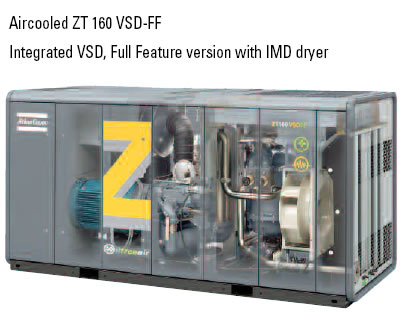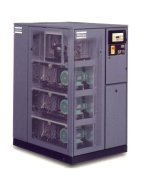Some important designs of compressors include:
• Reciprocating compressors— use
pistons driven by a crankshaft. They are both stationary and portable,
can be single
or multi-staged, and can be driven by electric motors or internal combustion
engines. Small reciprocating compressors from 5 to 30 HP are commonly
seen in automotive applications and are typically for intermittent duty.
Larger reciprocating compressors up to 1000 HP are still commonly found
in large industrial applications, but their numbers  are declining as
they are replaced by less costly rotary screw compressors. Discharge
pressures can range from low pressure to very high pressure (>5000
psi or 35 MPa).
are declining as
they are replaced by less costly rotary screw compressors. Discharge
pressures can range from low pressure to very high pressure (>5000
psi or 35 MPa).
• Rotary
screw compressors—uses two meshed rotating positive-displacement
helical screws to force the gas into a smaller space. These are usually
for continuous, commercial and industrial applications and are both
stationary and portable. Their application can be from 5 hp (3.7 kW)
to over 500 hp (375 kW) and from low pressure to very high pressure
(>1200 psi or 8.3 MPa). They are commonly seen with roadside repair
crews powering air tools. This type is also used for many automobile
engine superchargers because it is easily matched to the induction
capacity of a piston engine.
They can be oil flooded rotary
screw compressors or oil free
rotary screw compressors and can use variable
speed drive (VSD) controls to
greatly improve efficiency when
there is a fluctuating demand.
• Scroll
compressor—similar to a rotary screw device, this
one includes two interleaved spiral-shaped scrolls to compress
a gas. Its output is more pulsed than the latter and this factor
has caused its declining industrial use. Can be found in automotive
use as a supercharger.
Air compressors sold to and used by the general public are often attached on top of a tank for holding the pressurized air. Oil-lubricated and oil-free compressors are available.
 Applications
Applications
Gas compressors are used in various applications where either higher pressures or lower volumes of gas are needed:
• in pressurized aircraft to provide
a breathable atmosphere of higher than ambient pressure
• in jet engines to provide the great mass of operating fluid and, at high
altitudes, a high enough concentration of oxygen for combustion of the air
and fuel mixture. The power to turn the compressor comes from the jet's own
turbines.
• in medicine and manufacturing to store purified or manufactured gases in
a small volume
• as a medium for transferring energy, such as to power pneumatic equipment
• in refrigeration and air conditioner equipment to move heat from one place
to another in refrigerant cycles: see heat pump.
• in pipeline transport of domestic gas to move the gas from the production
site to the consumer
• in SCUBA diving, hyper baric oxygen therapy
and other life support devices to store breathing gas in a small volume such
as in diving cylinders
• in submarines to store gas for later use as buoyancy
• in turbochargers and superchargers to increase the performance of internal
combustion engines by concentrating oxygen
• at vehicle service stations for providing compressed air for filling pneumatic
tires
Temperature
Charles' law says "when a gas is compressed temperature is raised".
There are three possible relationships between temperature and pressure in a gas undergoing compression:
• isothermal - gas at final stage of compression is same temperature
as at beginning of compression. In this cycle, heat is removed at the
same rate as it is added by the work of compression. This is impractical
for a working machine.
• adiabatic - This assumes that there is
no heat transfer, into or out of the process, and that all work added is expended
in creating a pressure rise. Theoretical
temperature rise is T2 = T1·Rc((K-1)/K)), with T1 and T2 in degrees
Rankin or Kelvin, and K = ratio of specific heats (approximately 1.4 for
air). The rise in air and temperature ratio means compression does not follow
a simple pressure to volume ratio. This is less efficient, but quick.
• Polytropic - This assumes that heat may enter or leave the process, and that
work added can appear as both increased pressure (useful work) and increased
temperature above adiabatic (losses due to cycle efficiency). Cycle efficiency
is then the ratio of temperature rise at theoretic 100 percent (adiabatic)
vs. actual (polytropic).
Staged compression
Since compression generates heat, the compressed air is to be cooled between stages making the compression less adiabatic and more isothermal. The inter-stage coolers cause condensation meaning water separators with drain valves are present. The compressor flywheel may drive a cooling fan.
For instance in a typical diving compressor, the air is compressed in three stages. If each stage has a compression ratio of 7 to 1, the compressor can output 343 times atmospheric pressure (7 x 7 x 7 = 343).
Prime movers
There are many options for the "prime mover" or motor which powers the compressor:
• gas turbines power the axial and centrifugal flow compressors that
are part of jet engines
• steam turbines or water turbines are possible for large compressors
• electric motors are cheap and quiet for static compressors. Small motors
suitable for domestic electrical supplies use single phase alternating current.
Larger motors can only be used where an industrial electrical three phase alternating
current supply is available.
• diesel engines or petrol engines are suitable for portable compressors and
support compressors used as superchargers from their own crankshaft power.
They use exhaust gas energy to power turbochargers
Contact Us
Alabama Air Power, Inc.
1293 Hwy 87
Alabaster, AL 35007
PH 800-851-2231
PH 205-664-0192
FAX 205-664-4889
AIR-1 / AIRLUBE
1804 South Dixie Hwy
Dalton, GA 30720
PH 800-559-9268
PH 706-279-2030
FAX 205-664-4889
After hours Emergency Service Calls
We have service technicians on call 24 hours a day, 7 days a week. For emergency service after hours please call 205-500-9133.
Request a quote
Select below to send your request
by email to an appropriate product specialist.
Please include your contact information (name, phone, email,
company, location, etc.) and a full description of your needs.
We will contact y0u shortly.
Equipment Service or Parts
